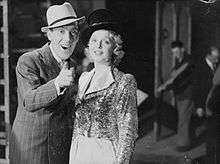Tommy Trinder
| Tommy Trinder | |
|---|---|
 | |
| Born |
Thomas Edward Trinder 24 March 1909 Streatham, London, England |
| Died |
10 July 1989 (aged 80) Chertsey, Surrey, England |
| Occupation | Comedian |
Thomas Edward Trinder CBE (24 March 1909 – 10 July 1989) known as Tommy Trinder, was an English stage, screen and radio comedian of the pre- and post-war years whose catchphrase was 'You lucky people'.
Life
Born at 54 Wellfield Road, Streatham, South London, (a plaque from the Streatham Society marks the spot) on 24 March 1909, the son of Thomas Henry Trinder, a London tram driver from Shilton, Oxfordshire, and his wife Jennie Georgina Harriet Mills, Tommy Trinder was one of the best-loved comedians in Britain during the period from the late 1930s until the 1960s.
He left school early for a job as an errand boy but by the age of 12 was on stage. He toured South Africa with a revue company in 1921 and appeared as a boy vocalist at Collins' Music Hall the following year. Minor successes in music hall, revues and working men's clubs followed. By 1926, aged 17, Trinder was the star of Archie Pitt's travelling variety comedy shows.
National recognition began to come in 1937 with the revues Tune In and In Town Tonight. By World War II he was one of Britain's foremost entertainers and his shows brought welcome relief during the darkest days of the war.

Ealing Studios signed him up to films during the war. His most famous was the comedy Sailors Three in which he, Claude Hulbert and Michael Wilding capture a German pocket battleship.
He also took straight acting parts in The Foreman Went to France, The Bells Go Down (a tribute to the work done by firemen in London during the Blitz); and Bitter Springs about a family fighting to make a new life in the Australian Outback.
He is believed to have originated "Trinder's Impossibility" - a "bar bet" where the mark is presented with a ten shilling note, partly torn through in two places at right angles to the long side and challenged to hold the two corners of the torn edge and tear it into three pieces. It cannot be done.
After the war, as a national figure he was soon recruited to television. In 1955, he became the first compere for the new ITV television programme Sunday Night at the London Palladium.
"He would begin his act with, 'The name's Trinder. That's T-R-I-N-D-E-R, pronounced Chumley.' This witticism was a gentle dig at the snobs of society, who insisted on pronouncing ordinary names in a fancy way which was utterly un-phonetic."[1]
He lived in an Art Deco-style apartment block – Du Cane Court, in Balham, south-west London – the largest such under one roof in Europe in the 1930s. He moved in with Violet Trinder (née Bailey; they had married in 1932) in 1939, and was still there in 1955. A neighbour described an impromptu encounter she had with him in which her silk scarf had covered her features. He said: "One should never hide a pretty face."[1] His second marriage was to Gwyn (Toni) Lancelyn Green. He moved to a large private estate, Burwood Park in Hersham, Surrey, calling the house "Tiverly". He is buried in Burval Cemetery, which is close by to where he lived.
He hosted his own TV series, Trinder Box on BBC, in 1959. He was the subject of This Is Your Life in May 1959 when he was surprised by Eamonn Andrews.
He was a lifelong devoted supporter of Fulham Football Club and was chairman of the club between 1959 and 1976.
In 1979 he appeared in an edition of The Old Boy Network, doing his stand-up routine and presenting a condensed history of his life and career.
Using a wheelchair after a stroke in 1986, he made his final television appearance in I Like The Girls Who Do recalling his contemporary Max Miller.
Always a favourite with the Royal family (he made six appearances in Royal Variety Performances between 1945 and 1980), he was awarded a CBE in 1975. He died on 10 July 1989.
A biography by Patrick Newley, You Lucky People! - The Tommy Trinder Story, was published in 2008 (Third Age Press).
Filmography
- 1938 - Save a Little Sunshine
- 1938 - Almost a Honeymoon
- 1939 - She Couldn't Say No
- 1940 - Sailors Three (aka Three Cockeyed Sailors in the U.S.)
- 1940 - Laugh It Off
- 1942 - The Foreman Went to France
- 1943 - The Bells Go Down
- 1944 - Fiddlers Three
- 1944 - Champagne Charlie
- 1950 - Bitter Springs
- 1955 - You Lucky People
- 1959 - Make Mine a Million
- 1963 - The Damned (aka These are the Damned in the U.S.)
- 1964 - The Beauty Jungle (aka Contest Girl in the U.S.)
- 1974 - Barry McKenzie Holds His Own
References
External links
| Wikimedia Commons has media related to Tommy Trinder. |
- Tommy Trinder at the Internet Movie Database
- Biography at biography.com
- Britmovie biography
- The Tommy Trinder Story autobiographical pamphlet
- Tommy Trinder's appearance on This Is Your Life